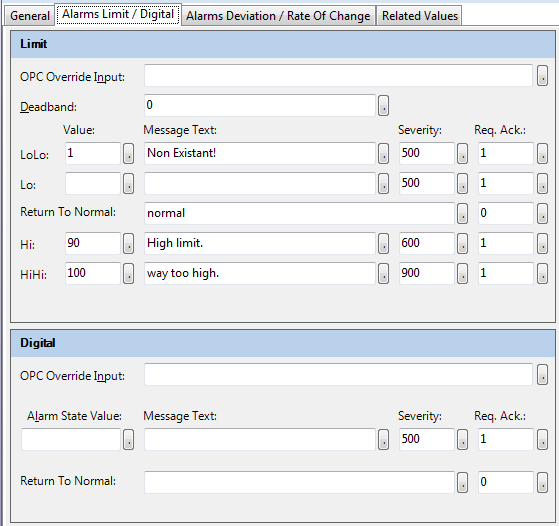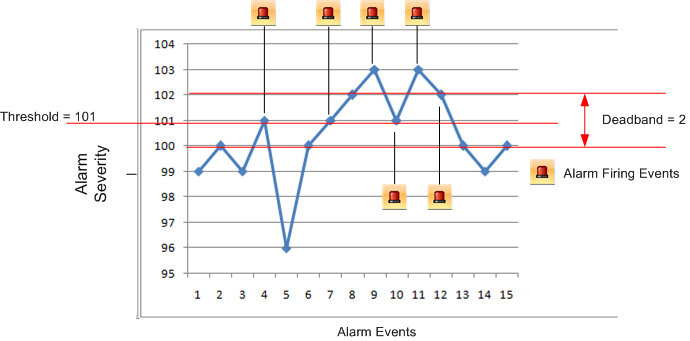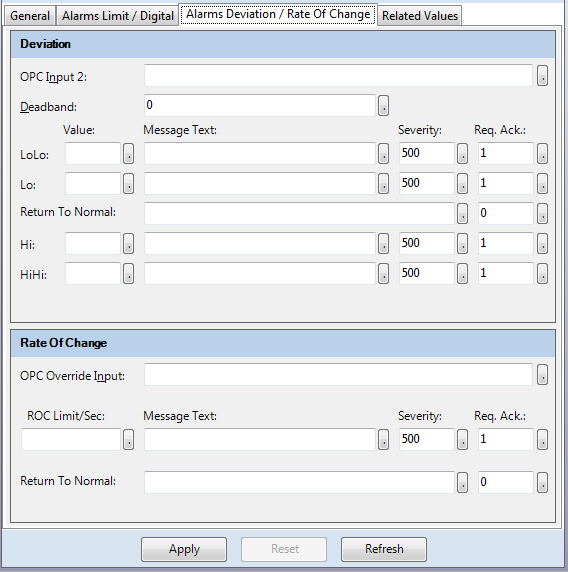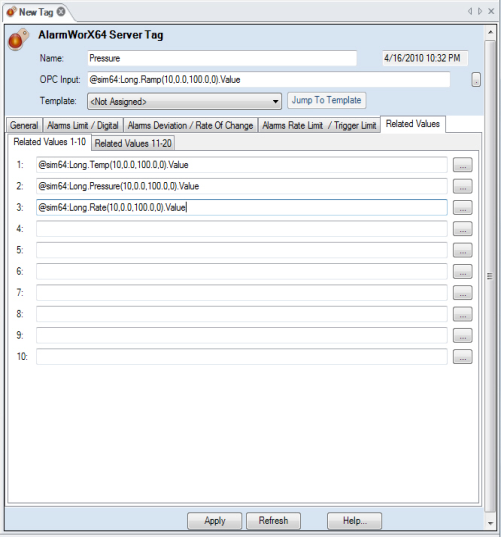Alarm Categories
All events generated are of the OPC-defined Event Type Condition. In the previous topic Alarm Tags the general alarm properties for all alarm tag types was described. This topic describes specific alarm categories expanding out what you find on the other tabs in the Alarm Source Server form.
The AlarmWorX64 Server defines the following Event Categories and uses the identical names for the Condition Names:
-
Deviation: Triggers an alarm if the difference between two input values exceeds the high or low limits specified in the Alarm Server configuration.
-
Digital: Triggers an alarm if the comparison between the Alarm State Value (specified in the Alarm Server configuration) and the input state is TRUE.
-
Limit: Triggers an alarm if the input value exceeds the high or low limits specified in the Alarm Server configuration.
-
Rate of Change: Triggers an alarm if an input value changes at a rate greater than or equal to the limit specified in the Alarm Server configuration.
|
|
Note: If data are entered on either the Limit or Deviation tabs, the tag is defined as an Analog tag. If data are entered on either the Rate of Change or Digital tabs, the tag is defined as a Digital tag. A tag that contains data on at least one tab from each group is classified as an Analog/Digital tag. |
The Limit and Deviation conditions have the following sub-conditions:
-
HiHi: Triggers an alarm if the value is greater than or equal to the HiHi limit specified in the Alarm Server configuration.
-
Hi: Triggers an alarm if the value is greater than or equal to the Hi limit specified in the Alarm Server configuration.
-
Lo: Triggers an alarm if the value is less than or equal to the Lo limit specified in the Alarm Server configuration.
-
LoLo: Triggers an alarm if the value is less than or equal to the LoLo limit specified in the Alarm Server configuration.
|
|
Note: The following categories are not used in the AlarmWorX64 Server : OPC Server Error, System Configuration, and System Messages. For more information, please refer to the OPC Alarm and Events specification at www.opcfoundation.org. To download the current OPC UA specification on alarms click here. |
Limit and Digital Alarms
The ![]() Alarm
Limit/Digital tab of the Alarm Server Source
Form sets the secondary OPC input and monitors that alarm's value compared
to thresholds or boundary limits that you set for the four levels of alarms:
Alarm
Limit/Digital tab of the Alarm Server Source
Form sets the secondary OPC input and monitors that alarm's value compared
to thresholds or boundary limits that you set for the four levels of alarms:
-
LoLo
-
Lo
-
Hi
-
HiHi
An alarm is triggered if the input value exceeds the high or low limits specified in the Alarm Server configuration.
The Limits type of alarm offers the following options:
-
OPC Override Input is used to replace the OPC Input 1 base field for the calculation of alarms. This field is optional and if left blank the default field of OPC Input 1 will be used.
-
Deadband applies a buffer amount surrounding a limit in which the alarm will not signal. The deadband value applies to converted analog values. The deadband value is required and is calculated on borderline alarming limit values to prevent repeated alarm cycles. An alarm series with a threshold of 101 (when the alarm triggers) and a deadband of +/-1 or 2 triggers in the instances with the alarm icon.
 Click
here to see an example.
Click
here to see an example. -
Value is used to calculate the state of the input fields. For example, a value of 10 for LoLo is compared with the value of OPC Input 1 or OPC Override Input to determine if the alarm is in LoLo state. An alarm is triggered if the input value exceeds the high or low limits specified in the Alarm Server configuration.
-
Message Text is the warning message that will appear when the alarm is sent. The message can be any text string, including a language alias (Unicode version only).
-
Return to Normal is the text that appear when the alarm is acknowledged. The message can be any text string, including a language alias (Unicode version only).
|
|
Note: It is not necessary to enter a message text or a base text. The Server will default to the OPC subcondition name and the OPC condition name. For example, a LoLo alarm will post a description of LoLo limit. |
-
Severity is the OPC-defined value for alarm Priority. The valid OPC severity range is 0 (lowest) to 1000 (highest).
-
Requires Ack sets an OPC condition that determines whether the alarm needs a user acknowledgement. If the Requires Ack field value is 1, then the alarm requires a user acknowledgement. If the value is 0, then the alarm is posted as already acknowledged.
|
|
Note: Changes to the alarm property fields (HiHi, LoLo, Hi, Lo, Message Text, etc.) made in runtime through an OPC tag update is automatically saved to the database, and will overwrite any values specified in configuration mode. |
The Digital section of the Limit Alarms tab sets an alarm if the comparison between the Alarm State Value and the input state is TRUE. The remaining fields on this tab are identical to those on the Limit tab.
Deviation and Rate of Change Alarms
The ![]() Deviation
tab of the Alarm Server Source, allows the configuration
of alarms where the limits are tested against the difference or delta
between two inputs: OPC Input 1 and OPC Input
2. The OPC Input 2
field is mandatory and is used to calculate the deviation from the OPC
Input 1 base field. An alarm is triggered if
the difference between two input values exceeds the high or low limits
specified in the Alarm Server configuration.
Deviation
tab of the Alarm Server Source, allows the configuration
of alarms where the limits are tested against the difference or delta
between two inputs: OPC Input 1 and OPC Input
2. The OPC Input 2
field is mandatory and is used to calculate the deviation from the OPC
Input 1 base field. An alarm is triggered if
the difference between two input values exceeds the high or low limits
specified in the Alarm Server configuration.
Deviation alarms have the following properties that you can apply. Some of them are identical in meaning to those just described in the Limit Alarm tag type. Deviation alarm properties include:
-
Deadband: Applies a buffer amount surrounding a limit in which the alarm will not signal. The deadband value applies to converted analog values. The deadband value is required and is calculated on borderline alarming limit values to prevent repeated alarm cycles.
-
Value: Triggers an alarm if the difference between two input values exceeds the high or low limits specified in the Alarm Server configuration.
-
Message Text: A warning message that will appear when the alarm is sent. The message can be any text string, including a language alias (Unicode version only).
-
Return to Normal: The text that appear when the alarm is acknowledged. The message can be any text string, including a language alias (Unicode version only).
-
Severity: The OPC-defined value for alarm Priority. The valid OPC severity range is 0 (lowest) to 1000 (highest).
-
Requires Ack: Sets an OPC condition that determines whether the alarm needs a user acknowledgement. If the Requires Ack field value is 1, then the alarm requires a user acknowledgement. If the value is 0, then the alarm is posted as already acknowledged.
The Rate of Change section of the Deviation Alarms tag tab triggers an alarm if an input value changes at a rate greater than or equal to the limit specified in ROC Limit/Sec. The remaining fields on this tab are identical to those on the Limit tab.
Related Values
The last tab found on the Alarm Source Server form is the ![]() Related Values tab.
Related values stores the condition of values at the time an alarm was
triggers. It is used to associate the occurrence of an alarm related conditions
that help diagnose the problem at a later date. Related values can be
the value of an OPC data access item, an expression or a constant expression.
This is often used to associate the occurrence of an alarm with a particular
lot or batch.
Related Values tab.
Related values stores the condition of values at the time an alarm was
triggers. It is used to associate the occurrence of an alarm related conditions
that help diagnose the problem at a later date. Related values can be
the value of an OPC data access item, an expression or a constant expression.
This is often used to associate the occurrence of an alarm with a particular
lot or batch.
The Related Values section provides an association between up to 20 OPC tags or expressions that you specify with each alarm tag. When an alarm triggers the related values tag can be use to store the conditions of that applied that the time the alarm went off. Consider a production process with an overall quality tag that triggers an alarm indicating that the quality has dropped below a certain value. The alarm by itself does little to tell the operator why the alarm triggered, and more importantly how to fix the error condition. Using related values it is possible to store the information from up to ten sensors or devices that make the error's cause more clear. For example, when a company runs a chocolate chip cookie production line and gets an alarm that the cookies are burnt, sensors can tell the operator if this is because the oven temperature is too high, the speed through the oven is too low, or some other related factor. The supplemental or related values become part of the permanent alarm record and are stored along with the alarm information. You can choose OPC tags and expressions for the various fields by clicking the arrow buttons.



